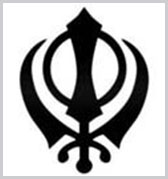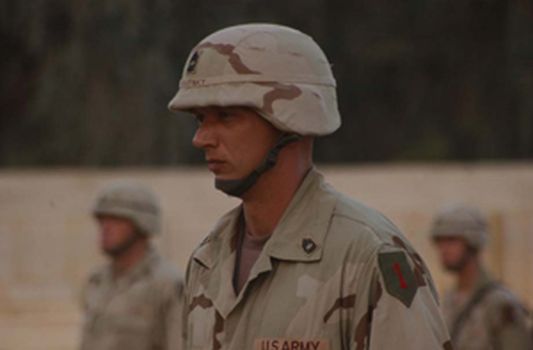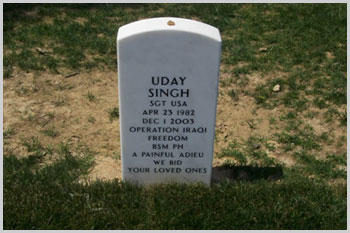The 36th Symbol
by Stephen Krivitsky

The Khanda

Stephen Krivitsky
I walked along the long rows, crisp freshly cut grass under my feet, the white stones reaching skyward, never ending. I found my friend quietly at rest. His white stone perfectly clean, perfectly polished, and perfectly silent. On this small pillar of white granite is etched the details for everyone who visits this hallowed place will read; Uday Singh, 1 DEC 2003, Purple Heart, Bronze Star, Meritorious Service Medal; Operation Iraqi Freedom. Atop the white pillar is a crest, the first of its kind allowed here in Arlington National Cemetery – the 36th authorized religious emblem – that of the Sikh Warrior, the Khanda.
Sergeant Uday Singh is buried among fellow warriors at the National Cemetery at Arlington, Virginia. As I look at him there at rest, I remember when I met him; his demeanor, his brilliance, his drive. He rode up on his motorcycle, returning from a long day of classes, steadily working toward his degree so he could be an officer like both his father and his grandfather. As he walked closer, I could see a proud, handsome young man, full of energy, smartly dressed, and professional. He introduced himself to me, and I to him. I remarked how I was aware of his six month “school option” where he would attend college for six months while still remaining in the unit. I asked how he was doing.
“Just fine, I couldn’t be happier! I’m about halfway through the semester,” he said proudly.
“How many classes are you taking?” I asked.
“Nine”
“What? Nine? How are you doing nine classes at once? Are you passing? Who signed off on that?” All I could think of was more questions.
“I’m heading for a B or better in all the classes… mostly A’s, though.” The gleam in his eye and the smile on his face said it all. He knew what he was doing, taking advantage of an opportunity to do a whole year of school in one semester. This kid is something, I thought: something very special.
Something special he was indeed. He finished that semester with better than a 3.4 GPA; impressive to say the least. Over the months, we got to know more and more about each other. I enjoyed his company, his skill, his drive. Uday’s long term plan was to become an Armor Officer, like his father in India, and be an American citizen. His superior efforts in his school work were indicative of his energy to reach the goals he set for himself. Uday was a fine young man, and I enjoyed watching him develop into a solid leader of Soldiers.
Later that year, we were alerted for a rapid deployment – off to Iraq. I had left early on the advanced party, and Specialist Singh with the main body of our battalion. The next time I saw him, we were in our new home in Habbaniyah, Iraq - between Fallujah and Ramadi in the center of the Sunni Triangle – west of Baghdad.
The time went by quickly, as the missions were never ending – always a job to do, somewhere to go, a bad guy on the loose, vehicles to search, houses to clear, bombs to find. He was in Third Platoon, the “Blacksheep”, doing great things for his adopted country with the Soldiers that were everything to him.
On the first of December 2003, before the Blacksheep went out on mission to provide route reconnaissance along a major thoroughfare, I saw him in the motor pool on his vehicle. He stood proudly in the hatch of his up-armored HUMMWV, like a modern day warrior on his steel horse. I had earlier found an article on the Indian Armored Force in World War II, and I thought he would find it interesting, as would his father. His family is very rich in military service and tradition, and this simple article would be a great story to send home to them – an Indian Sikh Warrior in Iraq sending home an article of Sikh Warriors from World War II. He thanked me, placed it in his pocket, checked his weapons, and smiled at me, acknowledging he was ready to ride. The heavy trucks thundered to life and rolled out the gate on their way to another mission and another long, hard day. I waved to Uday and all the Blacksheep as they went off to work for the day.
Less than an hour later, the battle began – at 0845 the Blacksheep were ambushed. The fighting lasted for two hours. Insurgents ambushed their trucks along that route they went to investigate. Never running from a fight, the Blacksheep fixed the enemy with direct fire, holding them in place as they used fire and maneuver to flank them. They called for a combined arms assault, providing indirect artillery on the insurgent’s position in coordination with the Quick Reaction Force (QRF) assault on their flank. The quick reaction force was on the way – but it was a 45 minute wait until they could get there – perhaps not so “quick” in reality. The platoon did everything it could to work its way across the elevated roads, around the canals, over the dirt mounds of the irrigated fields- everything they could to close with and destroy the enemy.
While engaging the enemy with his caliber .50 machine gun atop his mount, he was wounded in the fire fight. A bullet not seen and not heard found its mark – Uday. He fell to the truck’s floor lifeless, motionless.
The platoon continued to fight, and at the same time coordinated, organized, and executed an evacuation of Uday with a Blackhawk helicopter. He was pronounced dead at the hospital on the far side of Fallujah a short time later.
During the days that followed, the Company that Uday left behind continued to fight and survive in Iraq. Unknown to us, his family was to begin a great struggle, not just in dealing with their immense grief, but in a sea of bureaucracy.
Uday’s father, LTC Preet Singh, was a retired Amour Officer of the Indian Army. He was an exceptionally proud man; proud of his heritage, proud of his family, and most certainly proud of his son. Sorrow, grief, bereavement, sadness – none capture the pain and anguish he and his entire family underwent upon notification of his son’s death in war-torn Iraq. His actions and dedication to his son, his strong beliefs, and his untiring efforts during this most difficult time define his immeasurable pride and unyielding love for his son.
Uday’s remains were delivered to his family in Chandigarh, India a few days after his death. His funeral in India was scheduled for December 11, 2003. In attendance was the Commander of the United States Army Pacific Command, Lieutenant General James Campbell, the senior United States military official in the Eastern Hemisphere. The General’s involvement and eulogy at the funeral exemplifies the magnitude of this great loss to both India and America. Back in Iraq, we saw it on CNN International…
Uday was placed on a funeral pyre in his hometown of Chandigarh, India that day. His cremation is the first for any Indian Soldier lost in the War on Terror in Iraq, and it was filled with ceremony and tradition of two countries, the United States of America and India. The Sikh Warrior killed in combat is given this centuries old honor, traditionally marking his ascension into a far greater place where he will eternally stand guard. On his coffin, the American flag was draped, and Indian soldiers played Taps. After the traditional cremation of this fallen warrior, he would not stay in India close to his family. He would travel on to his adopted country.
LTC Singh and his family made a brave choice during their time of ultimate bereavement; they decided to have Uday’s final resting place in America, some 7,400 miles away – so that Uday could be among his fellow brothers in arms; where he could lie with his most honorable friends; so that the one’s he left behind could visit him. For a family to place their only son so far from themselves is a striking example of their unyielding pride of his service, a great respect for his chosen profession, and a strong loyalty to their son’s commitment to his fellow Soldiers.
On the 8th of January 2004, the final ceremony at Arlington National Cemetery received full military honors, as all fallen Soldiers from the far-away, distant conflicts are permitted. During the preparation time prior to the ceremony, the Singh family had to make more choices; difficult and varied choices of what the headstone should read. And there are rules that must be followed – only certain items may be inscribed on the headstone marking their terrible loss and their son’s ultimate sacrifice. It was then that they realized that Uday’s emblem of belief, or religious symbol, was not authorized at Arlington National Cemetery, nor any other American cemetery in the world.
Having lost their only begotten son, traveling across the globe to place him at rest amongst his dearest friends, the Singh family was shocked at the news. But, even in their grief, they solemnly set to task – to have the Sikh Emblem, the Khanda, placed on his headstone. Although it would take some time, they agreed to leave the top of his headstone blank until they could change the ways of the national cemetery.

Uday’s Headstone with no Emblem of Belief
In America, the land that is a shining example of what Religious Freedom means, her premier national cemetery didn’t recognize the emblem of the Sikh faith. This emblem, called the Khanda, symbolize the four pillars of their warrior religion. It consists of four traditional and symbolic weapons to their faith. In the center, a double edge sword is placed. Surrounding this sword is a circular medieval weapon called the Chakkar (or chakka) symbolizing the unity of God. On either side of these two weapons are crossed daggers or kirpans. They are named Piri and Miri after the personal weapons of the first Guru; they symbolize earthy and spiritual power in balance.

The Khanda
During a four month period following the death of his son, LTC Singh with the help of local Sikh religious leaders and friends in the United States Army, they struggled through the process to gain acceptance of the Khanda. LTC Singh smiles when he describes he and his friend’s plight, knowing the value and honor in a struggle for a grand purpose – not for anyone but for his son. On May 25th, 2004, LTC Singh received news of his efforts – the National Cemetery at Arlington announced the inclusion of the Khanda as the 36th authorized emblem of belief.
Quickly, almost as if overnight, the emblem was engraved onto the top portion of Uday’s headstone. A final tribute to his son and their religious convictions is now known to all who visit there.

Uday’s Headstone with the Khanda
As a father myself, I cannot comprehend the loss of an only son, nor the fortitude, dedication, devotion, and love that is represented in LTC Singh’s diligence and determination. If there is meaning to one’s life, or loss of it, perhaps this is one that will remain in my memory forever. The loss of my friend will always be a part of me, every day I keep a stone of remembrance in my pocket for those I have lost. I am a better man for knowing Uday, for I know he was a far better man than I will ever be – but to know that his death brought change to the greatest national cemetery – Arlington National Cemetery – brings me peace and solace. Uday Singh will live in the memory of thousands for eternity because of who he was and how his family triumphed during terrible loss and grief. No better tribute to a son, friend, Soldier, and warrior could have been crafted.
